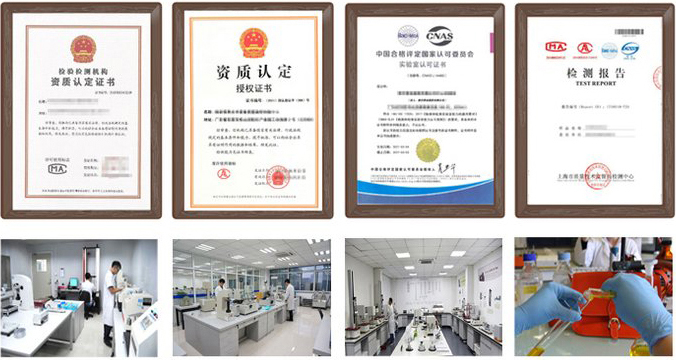Safety protection product testingHow to apply for a report? What items need to be tested? We will conduct testing and evaluation in strict accordance with the standards. We can also provide personalized testing plans and reports according to your needs.
The testing methods for safety protection products vary depending on the product type and testing standards. The following is an overview of the testing methods for some common safety protection products:
1. Safety helmet
Appearance inspection: Check whether the appearance of the safety helmet has obvious damage, cracks, fading, etc.
Internal pad inspection: Check whether the padding inside the safety helmet is intact and whether it is worn or deformed.
Impact performance test: Use a 3kg steel ball to drop vertically from a height of 5m to impact the safety helmet to check whether it is damaged.
Aging test: Place the safety helmet in a specific environment to simulate the aging after long-term use and check whether its performance has decreased.
2. Safety belt
Appearance inspection: Check whether the safety belt has wear, breakage, deformation, etc.
Load test: Use a special test rack to perform dynamic and static load tests. For example, during the static load test, hang a load of 225kg on the safety belt, hang it for 5 minutes, and check whether it is deformed or broken.
Ultimate tensile test: Test the ultimate tensile force of each component of the safety belt (such as belt, strap, safety rope, hook ring, etc.) to ensure that it meets the specified requirements.
III. Protective clothing
Appearance inspection: Check whether the appearance of the protective clothing is obviously worn, torn, deformed, etc.
Dimension measurement: Use measuring tools to accurately measure the size of the protective clothing to ensure compliance with relevant specifications and standards.
Compression performance test: Use standard testing equipment to check whether the protective clothing can withstand external forces within the specified pressure range.
Chemical resistance test: Put the protective clothing in contact with different types of chemicals to observe whether penetration, dissolution, etc. will occur.
Moisture permeability test: Evaluate the breathability and comfort of protective clothing in a humid environment.
IV. Protective gloves
Physical performance test: Measure the thickness, tensile strength, and other physical properties of the gloves.
Chemical resistance test: Put the gloves in contact with different types of chemicals to observe whether dissolution, corrosion, etc. will occur.
Waterproof test: Check whether the gloves have good waterproof performance.
Wearing suitability check: Wear gloves for various operations to check whether the gloves are suitable, flexible, and comfortable.
5. Goggles
Appearance inspection: Check whether the appearance of the goggles has obvious damage, cracks, deformation, etc.
Transparency inspection: Check whether the transparency of the goggles is good, and there should be no blur or distortion.
Impact resistance test: Use standard test equipment to test and check whether the goggles can effectively block projectiles of specified size and speed.
Heat resistance test: Evaluate the performance stability of goggles in high high-temperature environment.
6. Protective shoes
Appearance inspection: Check the appearance quality of protective shoes, such as whether the upper andsole are damaged or deformed.
Physical performance test: Measure the compressive strength, tensile strength, and other physical properties of protective shoes.
Anti-slip performance test: Evaluate the anti-slip performance of protective shoes in slippery environments.
Comfort test: Evaluate the comfort and breathability of protective shoes through trial wear and walking tests.
7. Comprehensive testing method
Quality inspection: Conduct physical performance tests and chemical performance tests on safety protection products to ensure that their manufacturing process and materials meet standard requirements.
Functional inspection: Functional inspection is carried out through special equipment, test methods, or actual use scenarios to verify whether the performance of safety protection products meets the requirements.
Actual use inspection: Put the safety protection products in an appropriate environment, simulate the actual use conditions, and check their stability, comfort, protection effect, etc. during use.
VIII. Precautions
Testing standards: The testing of safety protection products should be carried out in accordance with relevant national or international standards to ensure the accuracy and reliability of the test results.
Testing agency: Select a qualified and experienced testing agency for testing to ensure the fairness and authority of the test results.
Testing records: Record the test results and related information in detail for subsequent traceability and reference. For unqualified safety protection products, they should be replaced or repaired in time to ensure the safety of use.
In summary, the testing methods of safety protection products involve multiple aspects, including appearance inspection, physical property testing, chemical property testing, functional inspection, etc. Enterprises should select appropriate testing methods and standards according to actual needs, and conduct regular testing and maintenance to ensure the quality and safety of safety protection products.
Test report function
1、Project bidding: issue authoritative third-party CMA/CNAS qualification report;
2、E-commerce platform entry: quality inspection reports recognized by major e-commerce platforms;
3、Used as sales report: issuing a test report with legal effect to make consumers feel more at ease;
4、Papers and scientific research: providing professional and personalized testing needs;
5、Judicial services: providing scientific, fair and accurate testing data;
6、Industrial problem diagnosis: verifying the troubleshooting and correction of problems in industrial production;


 National free customer service telephone 400-101-7153
National free customer service telephone 400-101-7153 

